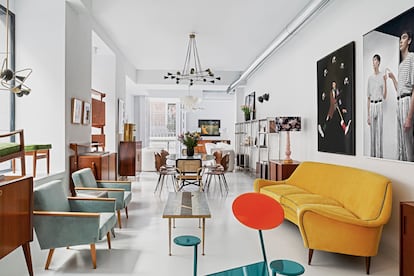They are sustainable, they are original and acquiring them can be an adventure.
Vintage
furniture
has always been an alternative to acquiring newly manufactured furniture, but, with the arrival of the pandemic and the consequent fever experienced with decoration, this type of old piece has taken on a special role in the interiors of many houses.
Although there are no official data on its sales, these usually go hand in hand with the furniture market itself: a sector that in Spain in 2021 experienced a rebound of 19.4%, reaching 1,630 million euros, according to the DBK Sector Observatory .
A little golden age of these
vintage jewels
(label with which those pieces that are at least 20 years old and no more than a century are called), to which the increase in web pages and applications for the sale of products between individuals has also contributed, where furniture has an exceptional place, or the opening of new specialized stores after the pandemic.
“These types of pieces were designed and built to last, so preserving a piece of furniture like this is, first, a sustainable way of decorating.
But it is also a way of preserving objects full of charm and history from oblivion”, says Luis Quiñones, responsible, together with Africa Salces, for La Recova, one of the most iconic stores in the Rastro area of Madrid.
From this space specialized in furniture from the 1950s, 1960s and 1970s, some precautions are recommended when purchasing a
vintage
.
The first and most indicative thing is that, as in love at first sight, we find it attractive.
We may not need to think much about your purchase, "since many are sold because of a crush," says Quiñones.
The next step is something more mundane: take a hard look at the state you are in.
“If a piece has lasted 50 or 60 years, taking care of it a little does not mean that it will not live for as many more.
A good piece of furniture can be seen with the naked eye”, explains Salces.
Although the eye of an expert has better resources than those of an amateur, you can try to recognize the type of wood from which the furniture is made and if it has any defects, observe the joinery work or the finishes that indicate its quality.
Exhibition of antique furniture in the El Receiver store, in Barcelona. CREDIT PHOTO
A correct restoration of the piece can make it look much more current, so don't be confused: just because it looks good, doesn't mean that it doesn't have decades of history.
In fact, experts do not advise acquiring them without restoring them, nor do we recommend doing it ourselves.
It almost always goes wrong.
“Buy restored always.
Restoring is an art, more than a trade, it is passion and experience.
For example, in our case it is the most important part of our business”, says Gerard Thomas, founder, together with Jorge Carrascosa, of El Receiver, a
showroom
and furniture store specializing in
mid-century
(those produced in the mid-20th century).
From this business in Barcelona with a decade of experience, they advocate reliable labeling of the origin and original state of each product so as not to sow distrust in the buyer.
“For us it is important to offer a token.
Indicate origin, designer, year of manufacture and material, as well as any curiosity about the furniture.
Not many do, but we believe it is relevant”, highlights Carrascosa.
'Showroom' of IKB191, in Madrid. Belén Imaz
Thanks to these measures, one can know if they are acquiring an authentic piece, a reissue or one inspired by an iconic model and combat one of the main dilemmas in the sector: pass off a piece of furniture for what it is not.
In this way, cases such as the
Chandigarh
armchairs by Pierre Jeanneret (a collaborator of Le Corbusier) would have been avoided, which, after decades of being shot with increasingly better copies, one original and one that is not, are practically impossible to distinguish.
“The imitations are usually for the super classics.
In any case, it is very evident that the result is wanting and not being able to —they warn from El Receiver—.
We all know how to see if a piece is real or an imitation, the price is always a clear indication of what we buy”.
In fact, whether it is a recognized piece, the firm or the creator can be another of the great dilemmas when deciding on one purchase or another.
Is it necessary to look at the designer?
Is the brand that edited it back in the day more important or what the piece makes us feel?
“A piece of furniture doesn't have to have a renowned designer or recognized editor behind it.
Not everything is a name”, explains Nicolás Poggetti from IKB191, one of the temples of collector's furniture in Madrid.
In its space in the central Barquillo street, it is not difficult to find pieces with "power and personality" by authors considered cultural heritage in countries like Italy and that in Spain are beginning to be increasingly in demand by a public eager for charming furniture that, in definitively, make our home a more welcoming place and more ours.
"The most important thing about a piece is that it amuses us and makes us happy beyond its functionality," continues Poggetti.
Above all, they have to help us create unique spaces that define us and make a difference”.

